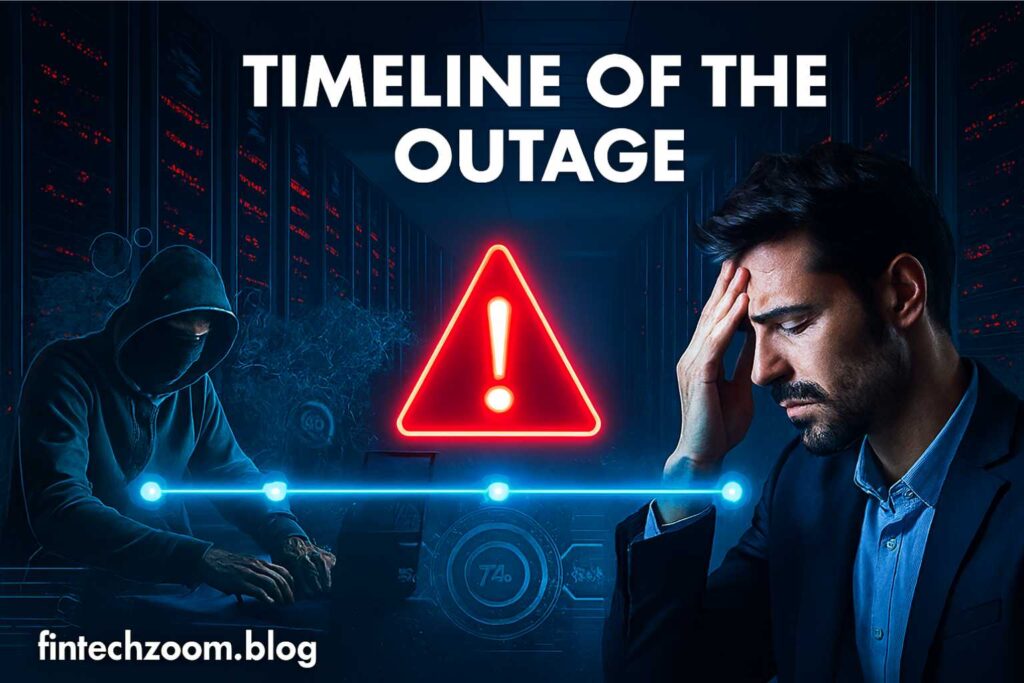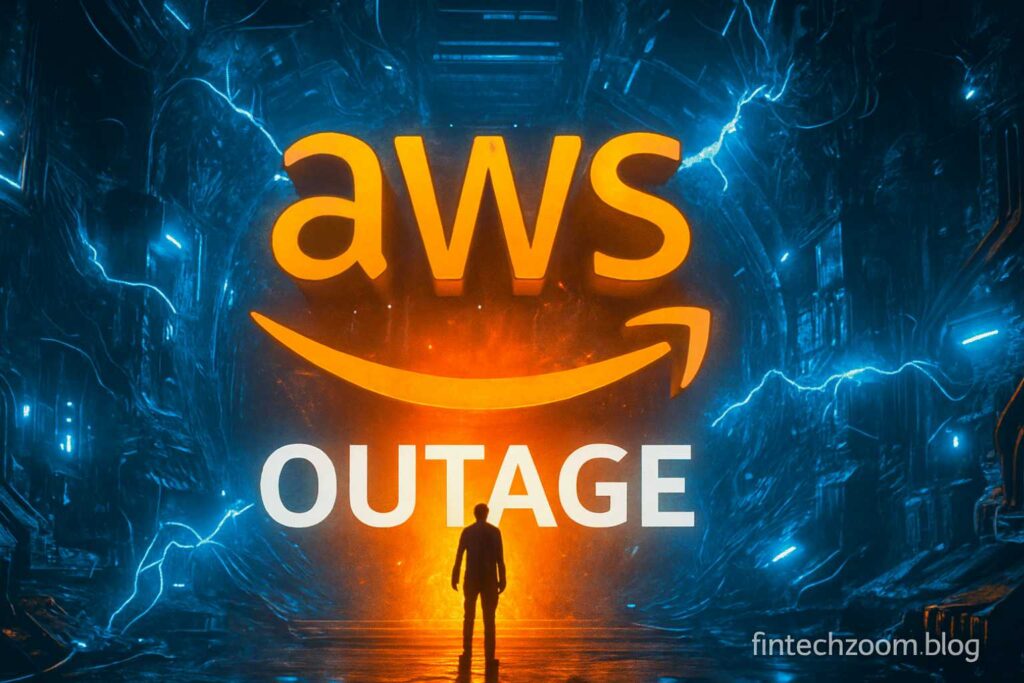Introduction
Unexpected system failures can shake even the most robust technology environments, and the recent Amazon Web Services (AWS) outage offered exactly that kind of wake-up call. On October 20, 2025, early morning hours in the US-East region witnessed a surge in error rates and latency across a number of key AWS services—rippling out to hit popular apps, gaming platforms, finance systems and global websites.
Such outages matter deeply because AWS underpins so much of the modern internet and enterprise cloud infrastructure. From startups to large enterprises, a single region disruption can cascade in surprising ways. This article will walk through the timeline, root causes, impact on business, lessons learned and how organisations can prepare better for next-time.

Timeline of the Outage
Midnight Pacific Time (3:11 a.m. ET) marked the first public alerts when the AWS status page flagged “increased error rates” for the US-East-1 region (Northern Virginia). Tom’s Guide+2ABC News+2
Over the next few hours the disruption broadened: major consumer apps and services reported failures in login, data retrieval and transaction processing. Around 5:22 a.m. ET AWS reported “early signs of recovery” as internal migrations were being applied. ABC News+2DataCenterDynamics+2
The scope showed global reach—thousands of users across multiple continents logged outage reports via services like DownDetector. The Economic Times+1
| Time (ET) | Milestone | Notes |
|---|---|---|
| ~03:11 | AWS reports error rates in US-East-1 | Outage begins |
| ~04:26 | Diagnosis points to DynamoDB endpoint | Internal subsystem flagged |
| ~05:22 | AWS mitigation underway | Partial recovery announced |
| Later morning | Most services restored | Some residual delays persist |
What Caused the AWS Outage?
A core driver of the outage was an internal issue within the US-East-1 region—specifically relating to AWS’s DynamoDB service and the underlying subsystem responsible for monitoring network load-balancers. DataCenterDynamics+2Newsweek+2
Given the size of AWS and the density of dependencies built into the cloud ecosystem, the failure of one key subsystem triggered widespread disruption. Many services rely indirectly on that same region for database queries, routing, and other infrastructure functions. The Guardian+1
Historically, AWS has had fewer significant outages compared to its scale—but this incident joins a list of region-specific failures (for example in US-West) that highlight cloud architecture risks when too much depends on a single region. Wikipedia+1

Who Was Affected & How Big Was the Impact?
Major platforms across gaming, streaming, finance and enterprise were impacted. For instance, services like Snapchat, Fortnite, and voice assistant systems tied to Amazon’s own ecosystem showed major failures. Reuters+1
Industries affected ranged from banking and payments (e.g., crypto trading platforms) to home-automation and streaming media. The geographical spread included the US, UK, Australia and more, demonstrating the global impact of an issue rooted in one region. Al Jazeera+1
Quantitatively the incident generated thousands of user reports: one monitoring site logged over 13,000 problem reports in short order. Cybernews+1
Implications for Businesses & Users
For businesses that depend on AWS, especially those utilizing a single region or lacking multi-region fail-safe strategies, this outage is a clear sign of systemic vulnerability. Trust in cloud infrastructure can suffer when one provider’s issue causes many downstream business failures.
From a user perspective, when your service provider’s provider fails, you may see login errors, data access delays, use-interruptions or payment processing failures—all albeit temporarily. For service providers themselves, incidents like this raise questions around dependency, regulation and continuity planning. Governments and regulators in the UK noted how much of the economy depends on a handful of large cloud providers. The Guardian+1
How to Mitigate Outage Risks for Your Own Infrastructure
Implementing multi-region deployments and fail-over capabilities becomes a non-optional practice for organisations serious about uptime. For example, having replica systems in other regions (not just US-East-1) can reduce the risk of single-point failure.
Monitoring systems must be robust—real-time dashboards, status pages (including AWS Health Dashboard) and alerting frameworks are essential. Communicating clearly and transparently with your users during an outage can also maintain trust rather than damage it.
Checklist for business owners:
- Ensure cloud infrastructure spans multiple regions
- Regularly test fail-over and disaster recovery
- Maintain an incident communication plan for users
- Subscribe to upstream provider status feeds
- Review dependencies to identify hidden single-region risks

What Comes Next? Future Trends & What to Watch
AWS is expected to publish a full post-event summary reflecting on this outage—based on past major events, a root-cause analysis and remediation roadmap will follow.
Cloud providers are under increasing pressure to improve transparency, to show how they handle resilience, and to reduce dependencies on single geographic zones. Emerging trends include edge computing and decentralized cloud infrastructure as ways to mitigate centralized risk. Businesses should plan for 2026 and beyond by re-evaluating their architecture with these trends in mind.
Also Read: Apple Watch Blood Oxygen Tracker Back in US – What’s New in 2025
Conclusion
The AWS outage of October 2025 served as a stark reminder that even the largest, most mature cloud providers are not immune to disruption. For fintechzoom. Blog readers—especially business owners and IT decision-makers—the key takeaway is that resilience matters more than ever. Designing infrastructure that anticipates failure, communicating with users during incidents, and diversifying cloud dependencies are no longer optional extras. As the cloud ecosystem evolves, organizations that prepare proactively will be the ones best positioned to turn disruption into differentiation.
FAQ About AWS Outage
Q1: Is the Amazon Web Services outage global?
Ans: Yes — the October 20 2025 outage impacted services worldwide, with reports spanning multiple continents and involving major platforms reliant on AWS infrastructure.
Q2: When was the last major AWS outage?
Ans: A widely documented significant incident occurred on June 13 2023 in the US-EAST-1 region, disrupting numerous services globally.
Q3: Was AWS affected by the CrowdStrike outage?
Ans: No, there’s no reputable evidence indicating AWS was directly impacted by the CrowdStrike-related July 2024 outage; they appear as separate incidents.
Q4: How often does AWS suffer major outages?
Ans: No cloud provider is immune to failures, but AWS has multiple regions and redundancy. Major outages are rare but possible—and this event underlines that even highly mature systems can face significant disruptions.
Q5: If AWS is down, will my service definitely go down?
Ans: Not necessarily. If your architecture uses multiple regions, has backups and is designed for resilience, you may see partial degradation rather than full failure. But reliance on a single region increases risk significantly.
Q6: What’s the difference between region-specific and global outages?
Ans: A region-specific outage affects one of the provider’s geographical zones (e.g., US-East-1). If that region serves many global services, the effect may appear global. A true global outage means multiple regions are impacted across the provider infrastructure.
Q7: Can I track AWS status in real time?
Ans: Yes—AWS publishes a Health Dashboard that shows service status by region, as well as updates on ongoing incidents. Staying subscribed to feed updates can help reduce surprise.

